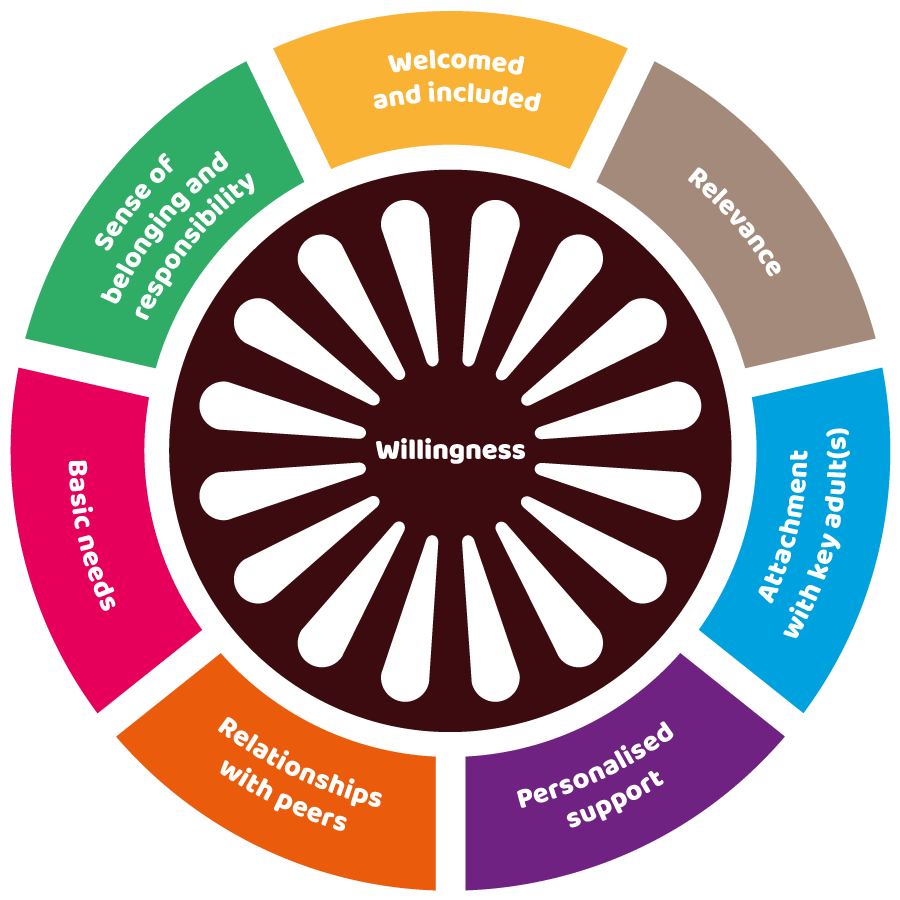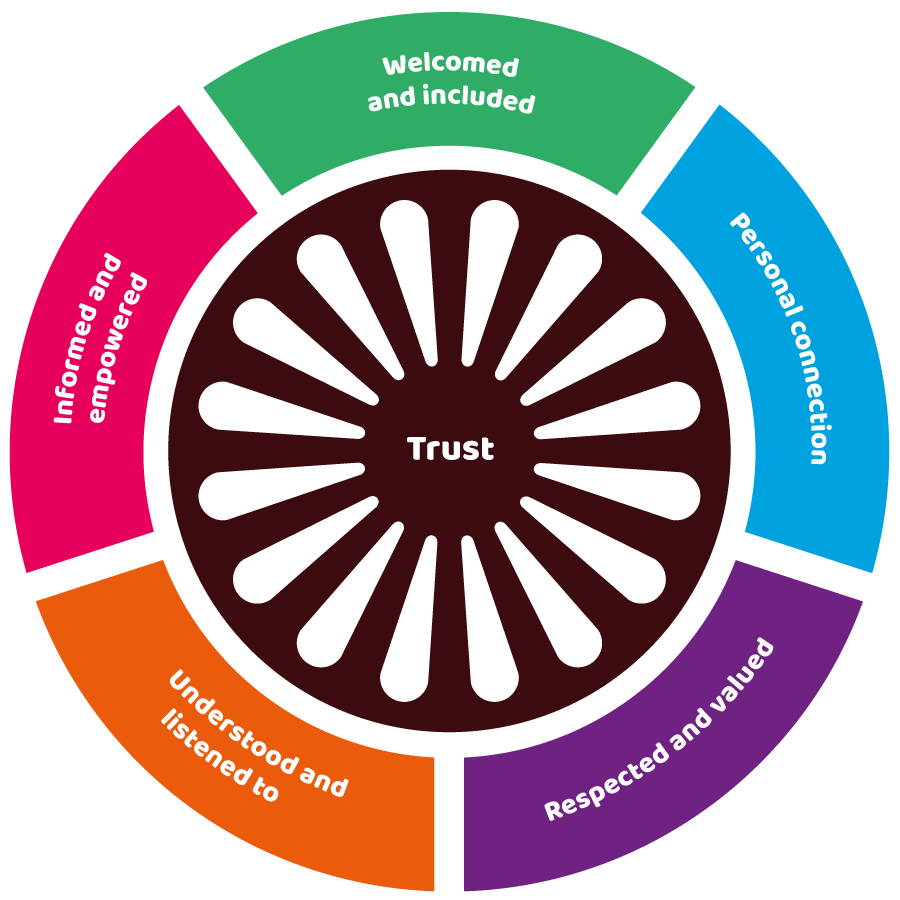Engagement
Best practice for building engagement
Under the Equalities Act, all services are legally expected to adapt their services and approaches to meet the needs of minority groups. This includes Gypsy, Roma and Traveller pupils and families. Working practices and timescales need to be adaptable to ensure equal access.
There are two main aspects of engagement to consider when working with the Traveller community. Visit these pages for cultural information and advice.
Building willingness to engage
You may also be interested in:
Communication (Written communication, Meetings, Phone calls, Home visits)
Consultancy
Building willingness to engage

These factors are essential for building children’s willingness to engage. Some of the principles apply to parents’ willingness to engage with services too.
Welcomed and included

How do children see that they are actively welcomed?
How is a child’s arrival made positive when they are late, or after an absence?
How are children supported to resettle and catch up after an absence?
How do children know that they are missed when they are not there?
How do you put children at ease if they are anxious, defensive or reluctant?
How do you make use of the child’s interests and strengths?
Relevance
Children’s willingness is increased if they see it as relevant to their life experiences, strengths, interests and goals.
Examples of common cultural strengths and interests (these must not be used to stereotype, but could be as starting point when observing younger children’s possible interests and experiences):
- practical activities
- physical activities
- problem-solving activities
- vehicles, including quadbikes and flatbed trucks used for work, horseboxes and trailers (caravans)
- real tools
- fixing and building
- gardening
- housekeeping
- floristry
- hair and make up
- animal care, especially horses and dogs
- opportunities to support younger children
- relating to older children and adults
- taking responsibility for particular jobs.
Attachment to key adult(s)

It is essential the child feels connected and safe with a key adult, otherwise they will not want to be there in case they have a problem and can’t come home or get help. If they do not have this connection with their main carer/teacher, it can be someone who checks in with them throughout the day, especially at any trigger points that they find difficult. Or, it could be someone who is always available for the child to go to if they feel the need.
Personalised support
Children will feel safe and willing to attend if they know that all staff understand them and how to support them to avoid or recover positively from their difficulties.
Cultural and emotional needs should be given high status when looking at the support a child needs. Routines, timings and rules should be considered creatively and flexibly, so that they are manageable and positive. Clear agreements should be made with the child and parent so that they know what is expected and what will happen next if it doesn’t work.
Relationships with peers

Children may need support to make links with their peers, and to feel connected to other children within the school. They may not be used to relating to children their own age, or children from outside their extended family community. It is common for children to show strong social skills and confidence within their home community, and to appear withdrawn or disconnected with their peers.
Building connections with their peers and having opportunities to mix with older children and support younger children, helps children to feel connected with their wider community and willing to attend.
Basic needs
If children are not used to the routines and structures, their basic needs could be barriers to concentration and learning and will affect their overall feelings about attending. They may need support to address these possible barriers:
- Hunger and thirst
- Toilet times and places
- Tiredness, especially if not yet in a routine of attending regularly
- Physical discomfort (uniform requirements)
- Restriction of movement (sitting still/sitting cross-legged)
- Extended periods of time indoors
- Privacy when changing
- Long periods of concentration
- Resting/time away from peers needed
- Sense of place – where to go, where not allowed, how to behave in different areas
- Crowded places
- Knowing and controlling when to speak
- Knowing appropriate words, e.g. alternatives to words considered unacceptable, without judgement
- Relating to people in authority, correct use of titles
- Understanding of unfamiliar words and phrases
- Missing part of a topic/lesson/unit of work
- Waiting for turns, waiting in lines
- Equipment
Sense of belonging and responsibility
Children need to develop a strong sense of belonging to feel willing to attend.
This is helped by:
- An arrival routine, including checking in with someone familiar (eye contact, gesture or conversation)
- Having a personalised place for their belongings
- Ensuring they are as visibly present as all other children (class displays and any named items such as pegs, lockers, drawers, water bottles)
- Identifying responsibilities for them within the classroom
- Opportunities to help others
- Building a positive identity and connections with peers
- Seeing a connection between themselves and the learning environment through resources reflecting their interests, having their work/contributions celebrated and on display
- Seeing that they are missed when they are absent, that their return is welcomed, and support is readily available to catch up.
Building trust

- Invest time in building relationships.
- Families may have multiple barriers affecting how easy it will be to trust you, for example:
- personal or historical experience of racism;
- negative judgements against them;
- fear of consequences of letting outsiders in;
- being let down by the system in the past.
- Whenever possible, arrange to be introduced by a well-known and trusted person who is already working with the family. Plan to do several joint home visits if necessary.
- Find out what the family might want from your support and focus on that first.
- Follow up on anything you said you would do, and report back to the family.
- Be creative and flexible.
- Be honest.
- Don’t promise anything unless 100% sure this will happen.
- For the family’s first visit, a known person should be there to welcome them (or offer to come with them). This could be the person they have spoken to on the phone.
- Keep to the same person working with the family. Support any necessary transfers / transitions.
- If you are referring the child or family to another service, support them to engage successfully.
Building trust in an educational setting
Here are additional factors to consider in order to build trust with families in educational settings.

Welcomed and included
How do parents and children see that they are actively welcomed?
How do parents and children know that they are missed when they are not there?
How do you make sure parents know about opportunities to get involved?
How do you put parents and children at ease, if they have had difficult experiences of education in the past?
How do you make use of parents’ interests and strengths?
How do you support parents’ confidence in getting involved, if they are anxious about being put on the spot or shown up?
Personal connection

Ensure warm and positive exchanges at arrivals and collections, even if these are very brief.
Look for every opportunity to build small connections between the key person/people and the child and parent.
Ensure that transitions are carefully supported so that trust is transferred as quickly as possible to the new key person/key people.
A personal connection with at least one ‘key person’ helps to build trust. It is good practice throughout education for parents and children to know who their key person is, and for this to be someone they connect with so that they can approach them comfortably about any problems. It can be anyone who is able to act as a supportive and accessible link between the parent and other staff. This reduces parents’ anxiety and builds trust and confidence in their children’s safety and wellbeing.
Respected and valued
GRT families can be on high alert to racism, negativity and judgement because of the experiences they have had in the past, or still have.
Families may assume that they are not respected or valued because of the way they have been treated by others. They may have had a difficult or traumatic experience of education.
A warm and friendly, ‘down-to-earth’ approach is the most effective way of showing respect and earning respect. Indifference, oversights, absent-mindedness and over-formality can all be interpreted as disrespectful, superior or negative.
Children are high up in the family hierarchy and are often treated as equals – especially boys. They may not recognise the authority of adults and may seem over-familiar. They are not being disrespectful – it is a cultural difference between home and education that needs to be supported sensitively. It is a cultural strength for children to confidently mix with all ages, including adults. Respect is given to adults who respect and value them. If children need to be taught to act differently around professionals in authority, this needs to be done sensitively otherwise they may feel they are not respected themselves.
Understood and listened to

Children and parents are unlikely to respect rules or sanctions that make no sense to them. They have a strong sense of what is fair and what is logical, so tend not to accept rules or authority at face value.
Questioning the norms, logic and problem solving are cultural strengths. Listen to the child’s or parent’s point of view before applying rules or sanctions. Be prepared to explain the reasoning behind them.
Seek parents’ and children’s views in a meaningful way and show that they are being acted on.
Informed and empowered

How do you ensure that all parents, including those who do not read emails or letters, know about:
- Rules and expectations
- Changes that affect their child
- Special events
- Help or resources need
Trust is lost when parents find themselves or their children unprepared or left out.
Trust is lost when rules and expectations are unclear, or when they are changed. A proper discussion with someone trusted means that any problems can be understood and sorted out.
